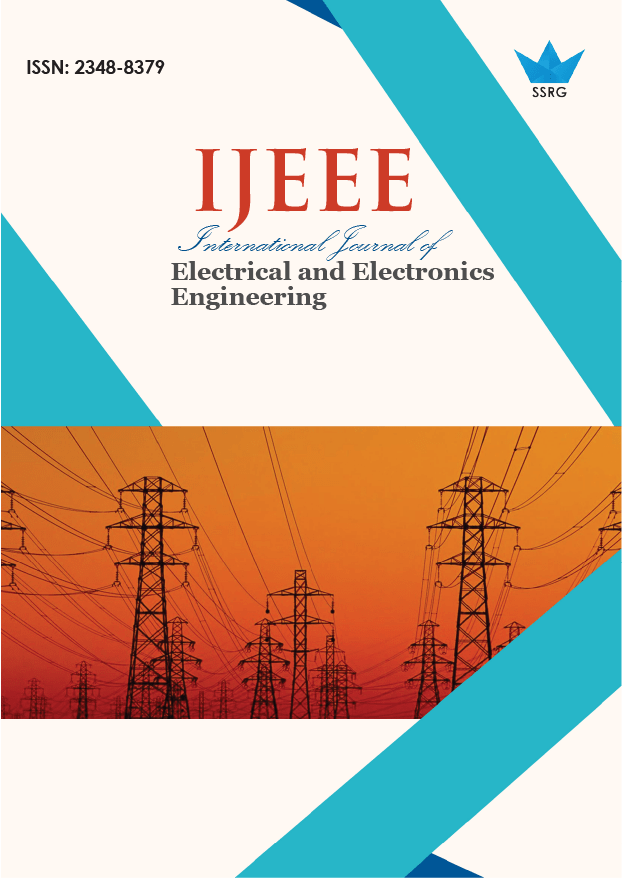PVA Nano Composites: Harvesting Electrical Energy from Mechanical Energy Using TENG

| International Journal of Electrical and Electronics Engineering |
| © 2025 by SSRG - IJEEE Journal |
| Volume 12 Issue 4 |
| Year of Publication : 2025 |
| Authors : B.S. Ravishankar, N. Mohan, Skanda P. Kashyap, B.H. Manish, Abhishek Gaviyappa, Tumakuru Nataraj Sowmya |
How to Cite?
B.S. Ravishankar, N. Mohan, Skanda P. Kashyap, B.H. Manish, Abhishek Gaviyappa, Tumakuru Nataraj Sowmya, "PVA Nano Composites: Harvesting Electrical Energy from Mechanical Energy Using TENG," SSRG International Journal of Electrical and Electronics Engineering, vol. 12, no. 4, pp. 268-278, 2025. Crossref, https://doi.org/10.14445/23488379/IJEEE-V12I4P121
Abstract:
Triboelectric Nanogenerators (TENGs) represent a rapidly advancing technology for harvesting mechanical energy and converting it into usable electrical power. Their integration into wearable electronics and self-powered sensing devices has driven interest in optimizing their performance through advanced materials. This study explores the effect of incorporating Yttrium-Doped Cerium Sulphide (Y₂CeS₅) nanoparticles into Polyvinyl Alcohol (PVA) matrices at varying concentrations (0-4%) to enhance the triboelectric output. A systematic characterization approach was employed to investigate structural, morphological, and chemical features of the resulting nanocomposites, using Scanning Electron Microscopy (SEM), X-Ray Diffraction (XRD), Fourier-Transform Infrared spectroscopy (FTIR), and Energy-Dispersive X-ray spectroscopy (EDX). SEM analysis revealed uniform nanoparticle dispersion within the polymer matrix, indicating effective mitigation of agglomeration and improved interfacial contact-key factors for charge enhancement. XRD results demonstrated minor yet significant changes in crystallinity, suggesting the evolution of structural phases. FTIR spectra affirm the formation of interfacial bonds and functional group interactions between nanoparticles and polymer chains, while EDX verifies successful elemental incorporation and composite homogeneity. Electrical performance analysis indicated a direct correlation between nanoparticle concentration and output voltage, with the highest loading yielding markedly improved power generation. The generated voltage was sufficient to illuminate a series of LEDs, establishing the practical viability of composite-based TENGs. These findings offer critical insights into how nanoparticle integration influences material properties and energy output. The study presents a promising pathway for engineering high-performance TENGs, contributing to advancing efficient, sustainable, and scalable energy harvesting technologies.
Keywords:
Electrostatic induction, Triboelectric effect, Energy-Dispersive X-ray spectroscopy (EDX), Fourier-Transform Infrared Spectroscopy (FTIR), Polyvinyl Alcohol (PVA), Scanning Electron Microscopy (SEM), Triboelectric Nanogenerators (TENGs), X-Ray Diffraction (XRD), Yttrium-Doped Cerium Sulphide (Y2CeS5).
References:
[1] Xin Lyu et al., “Direct-Current Output of Silicon-Organic Monolayer-Platinum Schottky Tengs: Elusive Friction-Output Relationship,” Nano Energy, vol. 114, 2023.
[CrossRef] [Google Scholar] [Publisher Link]
[2] Frederic G. Reamer, “The Digital and Electronic Revolution in Social Work: Rethinking the Meaning of Ethical Practice,” Ethics and Social Welfare, vol. 7, no. 1, pp. 2-19, 2013.
[CrossRef] [Google Scholar] [Publisher Link]
[3] Simiao Niu, and Zhong Lin Wang, “Theoretical Systems of Triboelectric Nanogenerators,” Nano Energy, vol. 14, pp. 161-192, 2015.
[CrossRef] [Google Scholar] [Publisher Link]
[4] Bhaskar Dudem et al., “Exploring the Theoretical and Experimental Optimization of High-Performance Triboelectric Nanogenerators Using Microarchitectured Silk Cocoon Films,” Nano Energy, vol. 74, 2020.
[CrossRef] [Google Scholar] [Publisher Link]
[5] Bhaskar Dudem et al., “Natural Silk-Composite Enabled Versatile Robust Triboelectric Nanogenerators for Smart Applications,” Nano Energy, vol. 83, 2021.
[CrossRef] [Google Scholar] [Publisher Link]
[6] Simiao Niu et al., “Theoretical Study of Contact-Mode Triboelectric Nanogenerators as an Effective Power Source,” Energy and Environmental Science, vol. 6, no. 12, pp. 3576-3583, 2013.
[CrossRef] [Google Scholar] [Publisher Link]
[7] Simiao Niu et al., “Theory of Sliding-Mode Triboelectric Nanogenerators,” Advanced Materials, vol. 25, no. 43, pp. 6184-6193, 2013.
[CrossRef] [Google Scholar] [Publisher Link]
[8] Simiao Niu et al., “Theoretical Investigation, and Structural Optimization of Single-Electrode Triboelectric Nanogenerators,” Advanced Functional Materials, vol. 24, no. 22, pp. 3332-3340, 2014.
[CrossRef] [Google Scholar] [Publisher Link]
[9] Bhaskar Dudem et al., “Wearable Triboelectric Nanogenerator from Waste Materials for Autonomous Information Transmission via Morse Code,” ACS Applied Materials and Interfaces, vol. 14, no. 4, pp. 5328-5337, 2022.
[CrossRef] [Google Scholar] [Publisher Link]
[10] Snigdha Roy Barman et al., “A Self-Powered Multifunctional Dressing for Active Infection Prevention and Accelerated Wound Healing,” Science Advances, vol. 9, no. 4, 2023.
[CrossRef] [Google Scholar] [Publisher Link]
[11] Jia-Han Zhang et al., “Enhancing Output Performance of Triboelectric Nanogenerator via Large Polarization Difference Effect,” Nano Energy, Vol. 84, 2021.
[CrossRef] [Google Scholar] [Publisher Link]
[12] P. Balaji Bhargav et al., “Structural, Electrical and Optical Characterization of Pure and Doped Poly (Vinyl Alcohol) (PVA) Polymer Electrolyte Films,” International Journal of Polymeric Materials and Polymeric Biomaterials, vol. 56, no. 6, pp. 579-591, 2007.
[CrossRef] [Google Scholar] [Publisher Link]
[13] Emerson Oliveira da Silva et al., “Effect of the Addiction of Metal Oxide Nanoparticles on the Physical, Chemical and Thermal Properties of PVA Based Nanocomposites,” Materials Sciences and Applications, vol. 9, no. 5, pp. 473-488, 2018.
[CrossRef] [Google Scholar] [Publisher Link]
[14] Zhong Lin Wang, “Triboelectric Nanogenerators as New Energy Technology for Self-Powered Systems and as Active Mechanical and Chemical Sensors,” ACS Nano, vol. 7, no. 11, pp. 9533-9557, 2013.
[CrossRef] [Google Scholar] [Publisher Link]
[15] Yanbo Zhu et al., “A Flexible and Biocompatible Triboelectric Nanogenerator with Tunable Internal Resistance for Powering Wearable Devices,” Scientific Reports, vol. 6, no. 1, 2016.
[CrossRef] [Google Scholar] [Publisher Link]
[16] Doga Doganay et al., “Triboelectric Nanogenerators from Fundamentals to Applications,” Nano Energy, vol. 138, 2025.
[CrossRef] [Google Scholar] [Publisher Link]
[17] Yang Wang, Ya Yang, and Zhong Lin Wang, “Triboelectric Nanogenerators as Flexible Power Sources,” NPJ Flexible Electronics, vol. 1, no. 1, 2017.
[CrossRef] [Google Scholar] [Publisher Link]
[18] Zhong Lin Wang et al., “Progress in Triboelectric Nanogenerators as a New Energy Technology and Self-Powered Sensors,” Energy and Environmental Science, vol. 8, no. 8, pp. 2250-2282, 2015.
[CrossRef] [Google Scholar] [Publisher Link]
[19] Van-Long Trinh, and Chen-Kuei Chung, “Advances in Triboelectric Nanogenerators for Sustainable and Renewable Energy: Working Mechanism, Tribo-Surface Structure, Energy Storage-Collection System, and Applications,” Processes, vol. 11, no. 9, pp. 1-33, 2023.
[CrossRef] [Google Scholar] [Publisher Link]
[20] Q.A. Murad Al-Gunaid et al., “Optical Parameters, Electrical Permittivity and I-V Characteristics of PVA/Cs2CuO2 Nanocomposite Films for Opto-Electronic Applications,” Journal of Materials Science: Materials in Electronics, vol. 28, pp. 8074-8086. 2017.
[CrossRef] [Google Scholar] [Publisher Link]

 10.14445/23488379/IJEEE-V12I4P121
10.14445/23488379/IJEEE-V12I4P121